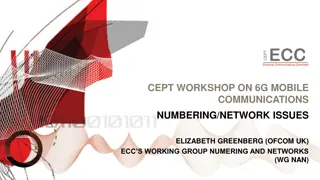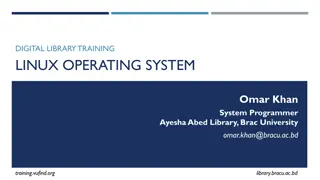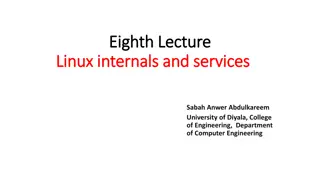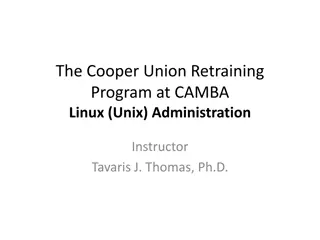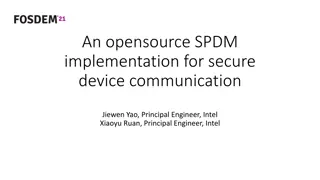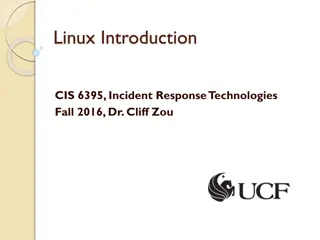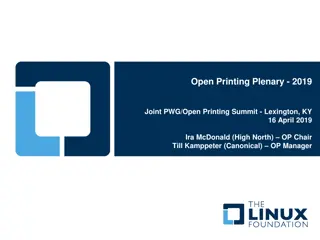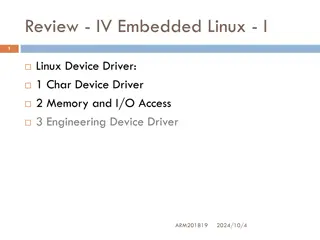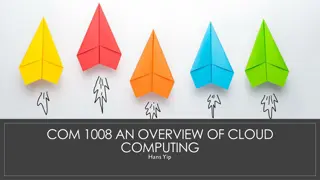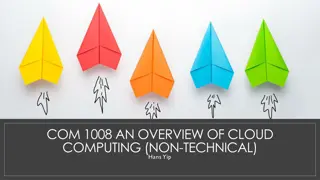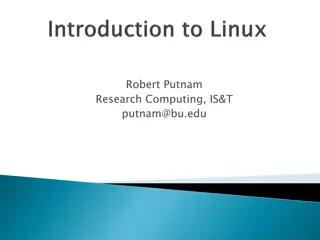Device Numbering in Linux
In Linux, device numbering involves major and minor numbers to identify devices like floppy disks and IDE disks. The major number signifies device type, while the minor number distinguishes specific devices within a group. Major and minor numbers are extracted with macros, and merged into a 16-bit number using MKDEV. The /dev directory attributes exemplify how the same major number can identify different devices. Dev_t data type is crucial for applications, with kdev_t evolving into a complete device file descriptor in future Linux versions.
Download Presentation

Please find below an Image/Link to download the presentation.
The content on the website is provided AS IS for your information and personal use only. It may not be sold, licensed, or shared on other websites without obtaining consent from the author.If you encounter any issues during the download, it is possible that the publisher has removed the file from their server.
You are allowed to download the files provided on this website for personal or commercial use, subject to the condition that they are used lawfully. All files are the property of their respective owners.
The content on the website is provided AS IS for your information and personal use only. It may not be sold, licensed, or shared on other websites without obtaining consent from the author.
E N D
Presentation Transcript
A number ranging from 1 to 255 that identifies the device type. Usually, all device
files having the same major number and the same type share the same set of file
operations, since they are handled by the same device driver.
A number that identifies a specific device among a group of devices that share the
identify the minor number. The MAJOR and MINOR macros extract the two values from the 16-bit number, while the MKDEV macro merges a major and minor number into a 16-bit number. Actually, dev_t is the data type specifically used by application programs; the kernel uses the kdev_t data type. In Linux 2.2 both types reduce to an unsigned short integer, but kdev_t will become a complete device file descriptor in some future Linux
/dev directory. The following illustrates the attributes of some device files. Notice how the same major number may be used to identify both a character and a block device.
Name Type Major Minor Description
/dev/hda2 block 3 2 Second primary partition of first IDE disk
/dev/hdb3 block 3 67 Third primary partition of second IDE disk
No system protection between threads in a process; the programmer is responsible for interactions.
Can share information between threads without IPC overhead.
associated kernel threads. Priorities falling within this class range 0-59 and are dynamically adjusted in an attempt to allocate processor resources evenly.
the in-focus window in the GUI. Its intent is to give extra resources to processes associated with that specific window. Like TS, IA s range is 0-59.
priority-based. Threads managed by FSS are scheduled based on their associated shares and the processor s utilization. FSS also has a range 0- 59.
for threads associated with this class are fixed (in other words, they do not vary dynamically over the lifetime of the thread). FX also has a range 0- 59.
to schedule kernel threads. Threads in this class are bound threads, which mean that they run until they block or complete. Priorities for SYS threads are in the 60-99 range.
time quantum. Their priorities range 100-159, so an RT thread will preempt a system thread. Of these, FSS and FX were implemented in Solaris 9.
THE SOLARIS BOOTUP AND SHUTDOWN
FIG. 1 SOLARIS BOOTUP PHASES
default boot device OpenBoot value on most system is the disk or disk:a. A second boot device (net) can be also be specified. If for some reason the first boot device does not work, the second boot device is tried.
If the auto-boot?variable is set to false the system stops at the OK prompt.
the RSS column of ps ly or top. dbx, the debugging utility in the SunPro package, has extensive memory leak detection built in. The source code will need to be compiled with the g flag by the appropriate SunPro compiler. Ipcs mb shows memory statistics for shared memory. This may be useful when attempting to size memory to fit expected traffic.
combines physical memory with available swap space via swapfs. If insufficient total virtual memory space is provided, new processes will be unable to open.
Swapping(swaps out all memory associated with a user process) and
Download paging (swaps out the not recently used pages)
architecture is known as the cyclical page cache. The cyclical page cache uses a file system free list to cache file system data only. Other memory objects are managed on a separate free list
SECURITY File Integrity and Secure Execution User and Process Rights Management Network Service Protection
protection against maliciously crafted networking packets. Starting in Solaris 10 8/07, the IP Filter firewall can also filter traffic flowing between Solaris Containers when it is configured in the Global Zone. In addition, TCP Wrappers are integrated into the Solaris 10 OS, limiting access to service-based allowed domains. Cryptographic Services and Encrypted Communication
accelerated, cryptographic functions. The pluggable Solaris Cryptographic Framework can balance loads across accelerators, increasing encrypted network traffic throughput, and it is available to applications written to use Public Key Cryptography Standards (PKCS) #11, Sun Java Enterprise System, NSS, OpenSSL, and Java Cryptographic Extension software. Flexible Enterprise Authentication
Pluggable Authentication Mechanism (PAM), which make it possible to add authentication services to Solaris dynamically. Sun and third-party vendors provide many PAM modules and customers can create their own to meet specific security needs.


